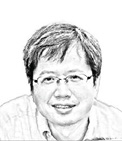Artist combines ink wash and calligraphy
FOR Shanghai artist Tong Jianying, each piece of his abstract ink wash rubbings is a unique “accident” that cannot be reproduced.
He carves calligraphy into wood tablets, splashes them with colored ink and rubs rice paper over the images.
Some works look like ancient, abstract ideograms from a cave wall. He blends the beauty of traditional Chinese calligraphy with a contemporary sensibility.
Tong’s ongoing gallery exhibition “Water Produces Wood” features 17 ink wash rubbings and six wood sculptures.
Through his works, viewers can see multiple layers and explore multiple meanings.
“On the wood tablet I carve Chinese characters, and rub the character tablet onto Chinese rice paper,” Tong tells Shanghai Daily. “Though the processes are rather primitive, after spreading ink and dye, it buoys up with unexpected effects.”
The result of his experiments in 1988 is what he calls colored inscription rubbings and they became his signature.
Tong, who teaches at Fudan University, has held numerous solo exhibitions and taken part in more than 40 international exhibitions.
The exhibition title “Water Produces Wood” refers to the interactions of two of the five universal elements — water, wood, fire, earth and metal.
It suggests that all things are the result of change. Water is indispensable to the life of wood and wood repays water generously.
Tree trunks can be made into boats, houses and articles. Even after burning, wood ash can be made into ink sticks, then dissolved into water for writing and painting on paper, which is made of wood. The five elements produce and subdue one another in endless chains.
Tong said it can take days or months to complete one work “because it’s tricky when you play with rice paper and ink wash — the ink pattern changes too much when it dries.”
He also tries to find the perfect state of mind before splashing the ink. “The splash is always an accident and cannot be reproduced,” he observes.
Midnight is his preferred time to splash colored ink because there’s less interference and distraction at that time.
“Tong reflects the formations of the world’s images and their moving law, through the principle of opposition and unification. Just like paintings with emotion, and music without sound,” said Chen Rong, president of Art Affairs in Macau, where Tong worked for five years.
“The uniqueness of Tong’s work is that it presents concrete images or characters in an abstract way,” said curator Xu Lianghai, who is also the owner of Fan Gu Zi Art Gallery, where the exhibition is underway.
Born into an intellectual family, Tong learned calligraphy at a young age. He studied oil painting and graduated from the Jiangxi Province Arts College. After joining the Chinese Artists’ Association in 1994, he developed his own style combining Eastern and Western influences.
Exhibition: Water Produce Woods
Date: Through March 22, 1-6pm
Venue: Fan Gu Zi Art Gallery
Address: 127 Xianxia Rd
- About Us
- |
- Terms of Use
- |
-
 RSS
RSS - |
- Privacy Policy
- |
- Contact Us
- |
- Shanghai Call Center: 962288
- |
- Tip-off hotline: 52920043
- µ▓¬ICPĶ»ü’╝ܵ▓¬ICPÕżć05050403ÕÅĘ-1
- |
- õ║ÆĶüöńĮæµ¢░ķŚ╗õ┐Īµü»µ£ŹÕŖĪĶ«ĖÕÅ»Ķ»ü’╝Ü31120180004
- |
- ńĮæń╗£Ķ¦åÕɼĶ«ĖÕÅ»Ķ»ü’╝Ü0909346
- |
- Õ╣┐µÆŁńöĄĶ¦åĶŖéńø«ÕłČõĮ£Ķ«ĖÕÅ»Ķ»ü’╝ܵ▓¬ÕŁŚń¼¼354ÕÅĘ
- |
- Õó×ÕĆ╝ńöĄõ┐ĪõĖÜÕŖĪń╗ÅĶÉźĶ«ĖÕÅ»Ķ»ü’╝ܵ▓¬B2-20120012
Copyright ┬® 1999- Shanghai Daily. All rights reserved.Preferably viewed with Internet Explorer 8 or newer browsers.


